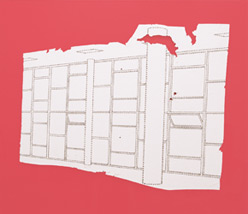Paulo Climachauska
dal 8/5/2005 al 18/6/2005
Segnalato da
8/5/2005
Paulo Climachauska
Lurixs Arte Contemporanea, Rio de Janeiro
Palace. ''Along the recent years, the work of P. Climachauska has consisted of a picto/graphic exercise composed of an obsessive repetitional operation that admits the persistence of a forced stability, due to the calculation of the zonal occupation of totally planar surfaces such as Formica, transparent glass or museum walls...''. Justo Pastor Mellado

Palace
REDUCTIVE TRANSFER AS MATERIAL SUBTRACTION
Along the recent years, the work of Paulo Climachauska has consisted of a picto/graphic exercise composed of an obsessive repetitional operation that admits the persistence of a forced stability, due to the calculation of the zonal occupation of totally planar surfaces such as Formica, transparent glass or museum walls, displaying references that are related to a certain stage of self-representation in Brazilian art occurring within the context of the late 90s.
The graphic layout of the work presented by the artist at the 26th São Paulo Biennial consisted of a mirrored projection of the diagram of the Biennial building in a life-size, 1:1 scale. The artist was thus seeking to reiterate the symbolic appropriation of the ‘house of art’, as if the specular projection of the diagram would encompass and contain the existing threat regarding its permanence. Therefore, it was very important to mark the play of stability by means of a line formed by numbers, albeit constantly concerned with establishing relations of representational equality between the image and its referent. This operation plays with the desire of modernity in Brazilian art to be equal to itself, that is, to the extent of its adequate reproduction.
The current subtraction work carried out by Paulo Climachauska is engaged in delimitating the attainment of any excess by retraction, making use of a graphic borderline stripe designed to retain the figure composed by the enchained succession of numbers, whose purpose can be none other than that of covering up the impossibility of retaining the un-representable excess of reality. There is no surplus at the image level.
The dread of trespassing the limit, the boundary that, as a formal attribute, defines this work, drives the artist to a precise and strict handling of the representable chain of flows that nullify one another. Nonetheless, every subtraction operation leaves behind the graphic imprint of their existence, thus creating a sort of ground zero of the energy field that destabilizes the idea of some possible affiliation.
In this field of extreme visual prophylaxis, affiliation lies essentially in the representation of its origins and in the layout of the voids. At a distance of a few meters, what we see is a blurred line. However, when we get closer, the distinctness of the numbers appears as the representation of a suture.
In brief, what is impossible to be attained in the plane of economic reality seems to be at least configured in the parodic representation of its possibility. Is economy concerned with reality, whereas art is only concerned with the symbolic? Certainly not, for ‘this’ reality is supported by a symbolic economy that affects the very idea of fetish ascribed to merchandises and consumer goods and, in the field of visuality, the dread of any excess is anchored to the fear of visibility – not of the objects, but of the processes of reproduction.
Hence, the need to curb the numbers as if, by dint of this maneuver, it would be possible to balance what cannot be stabilized. The repetitional numeral ‘graphemes’ follow the lines of some of the emblematic structures of Brazilian modernist architecture. Only one of the lines formed by the enchainment of subtraction operations (as in a school textbook) reproduces the diagram in a perspective that is self-exhausting in its ornamental drive.
The work represented at the São Paulo Biennial had to have its physical counterpart, and what it has gained in materiality was obtained through material subtraction. The work was reduced to transportable fragments capable of being fixated on walls for the sake of meeting the methodological requirement of displaying the scale dimension of its reductive transfer. This is the radical reach of its Pompeian quality that, by means of a dislocation effect, provides the visibility of the ruins with the possibility of reconstructing what’s missing in history.
Justo Pastor Mellado
Santiago de Chile, March 2005
Translation: Paulo Andrade Lemos
Rio de Janeiro, March 2005
Image: Untitled, from Palace series- Paulo Climachauska, 2005. Plexiglass, PVA and permanent marker, 126 x 150 cm
LURIXS
ARTE CONTEMPORÂNEA
RUA PAULO BARRETO 77, BOTAFOGO
22280-010 RIO DE JANEIRO
Exhibition hours
Mon - Fri 2 pm - 7 pm
Sat 4:30 pm - 8 pm



